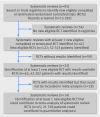Impact of searching clinical trial registries in systematic reviews of pharmaceutical treatments: methodological systematic review and reanalysis of meta-analyses
- PMID: 28213479
- PMCID: PMC5421496
- DOI: 10.1136/bmj.j448
Impact of searching clinical trial registries in systematic reviews of pharmaceutical treatments: methodological systematic review and reanalysis of meta-analyses
Abstract
Objective To evaluate the impact of searching clinical trial registries in systematic reviews.Design Methodological systematic review and reanalyses of meta-analyses.Data sources Medline was searched to identify systematic reviews of randomised controlled trials (RCTs) assessing pharmaceutical treatments published between June 2014 and January 2015. For all systematic reviews that did not report a trial registry search but reported the information to perform it, the World Health Organization International Trials Registry Platform (WHO ICTRP search portal) was searched for completed or terminated RCTs not originally included in the systematic review.Data extraction For each systematic review, two researchers independently extracted the outcomes analysed, the number of patients included, and the treatment effect estimated. For each RCT identified, two researchers independently determined whether the results were available (ie, posted, published, or available on the sponsor website) and extracted the data. When additional data were retrieved, we reanalysed meta-analyses and calculated the weight of the additional RCTs and the change in summary statistics by comparison with the original meta-analysis.Results Among 223 selected systematic reviews, 116 (52%) did not report a search of trial registries; 21 of these did not report the information to perform the search (key words, search date). A search was performed for 95 systematic reviews; for 54 (57%), no additional RCTs were found and for 41 (43%) 122 additional RCTs were identified. The search allowed for increasing the number of patients by more than 10% in 19 systematic reviews, 20% in 10, 30% in seven, and 50% in four. Moreover, 63 RCTs had results available; the results for 45 could be included in a meta-analysis. 14 systematic reviews including 45 RCTs were reanalysed. The weight of the additional RCTs in the recalculated meta-analyses ranged from 0% to 58% and was greater than 10% in five of 14 systematic reviews, 20% in three, and 50% in one. The change in summary statistics ranged from 0% to 29% and was greater than 10% for five of 14 systematic reviews and greater than 20% for two. However, none of the changes to summary effect estimates led to a qualitative change in the interpretation of the results once the new trials were added.Conclusions Trial registries are an important source for identifying additional RCTs. The additional number of RCTs and patients included if a search were performed varied across systematic reviews.
Published by the BMJ Publishing Group Limited. For permission to use (where not already granted under a licence) please go to http://group.bmj.com/group/rights-licensing/permissions.
Conflict of interest statement
Competing interests: All authors have completed the ICMJE uniform disclosure form at
Figures
References
-
- Cook DJ, Mulrow CD, Haynes RB. Systematic reviews: synthesis of best evidence for clinical decisions. Ann Intern Med 1997;126:376-80. 10.7326/0003-4819-126-5-199703010-00006 pmid:9054282. - DOI - PubMed
-
- Bastian H, Glasziou P, Chalmers I. Seventy-five trials and eleven systematic reviews a day: how will we ever keep up?PLoS Med 2010;7:e1000326 10.1371/journal.pmed.1000326 pmid:20877712. - DOI - PMC - PubMed
-
- Higgins JPT, Green S. Cochrane handbook for systematic reviews of interventions. Cochrane Collab 2011;version 5. http://handbook.cochrane.org/
-
- Higgins JP, Altman DG, Gøtzsche PC, et al. Cochrane Bias Methods Group Cochrane Statistical Methods Group. The Cochrane Collaboration’s tool for assessing risk of bias in randomised trials. BMJ 2011;343:d5928 10.1136/bmj.d5928 pmid:22008217. - DOI - PMC - PubMed
-
- Moher D, Tetzlaff J, Tricco AC, Sampson M, Altman DG. Epidemiology and reporting characteristics of systematic reviews. PLoS Med 2007;4:e78 10.1371/journal.pmed.0040078 pmid:17388659. - DOI - PMC - PubMed
Publication types
MeSH terms
LinkOut - more resources
Full Text Sources
Other Literature Sources


